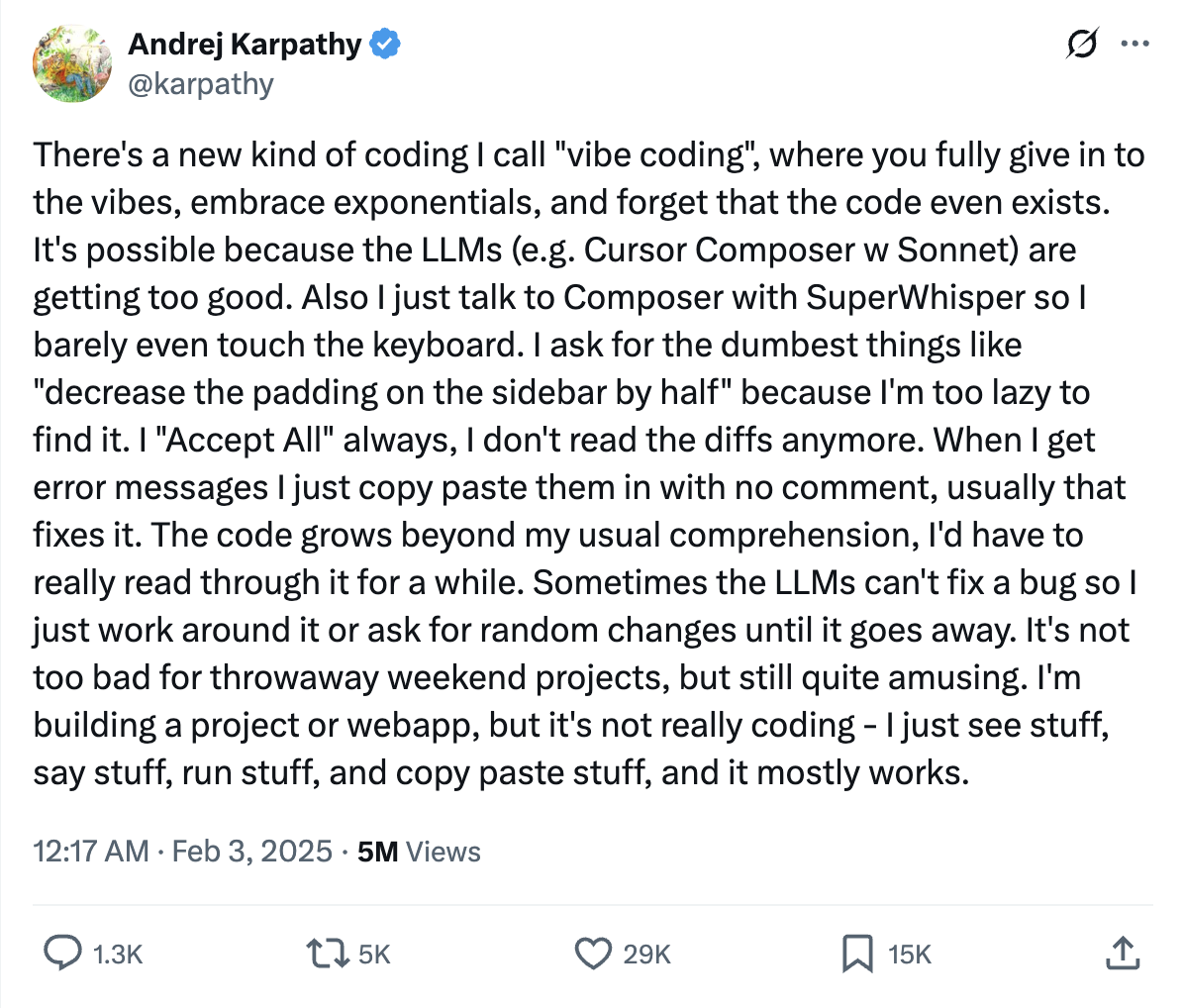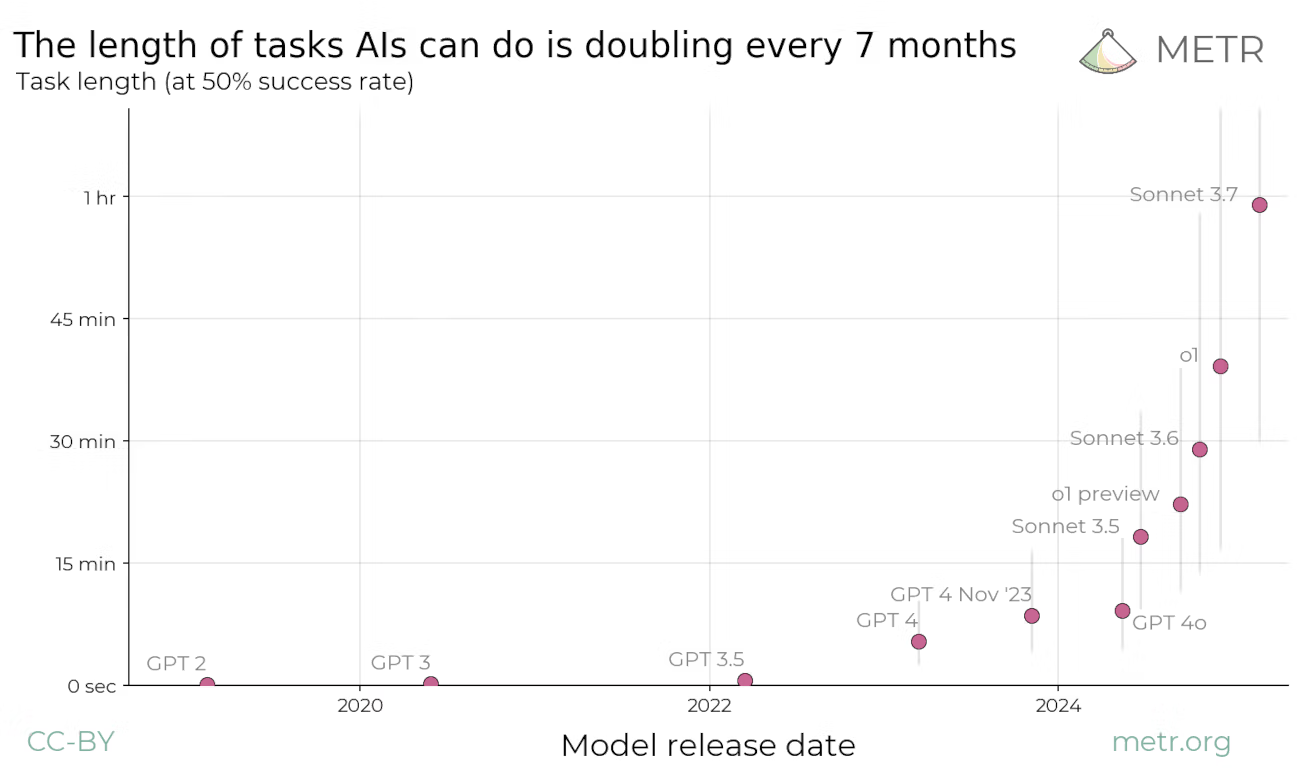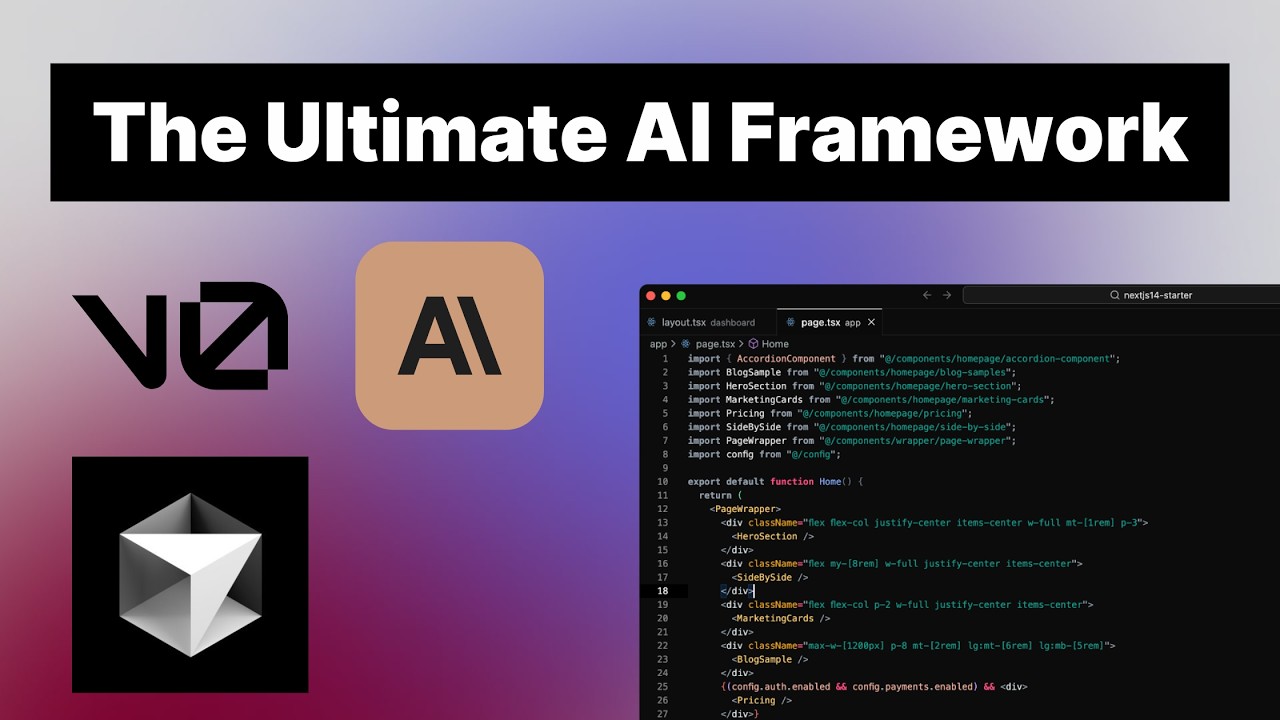Vibe coding guide
Explanation, best practices, tools, and key people to follow, to master vibe coding.
A lot of work is still required to improve this guide - thanks for reading in the meantime!
Introduction
In Silicon Valley, we're paid to see the future. And right now, the future is whispering – or rather, vibing – a new way to build. This isn't just another catchy phrase destined for the tech buzzword graveyard. It's a symptom of a profound technological tremor.
This guide cuts through the ambient noise. It offers the venture capitalist's perspective: the seismic opportunities, the hidden pitfalls, and an actionable playbook for founders and investors. Because this isn't merely about AI scribbling lines of code; it's about a fundamental re-architecture of how ideas are manifested into market-ready products.
What is vibe coding?
Definition
Vibe coding is an emerging approach to software development that leverages artificial intelligence, specifically large language models (LLMs), to generate code based on natural language prompts. This method allows individuals to express their software ideas in plain language, with the AI handling the technical coding process. The role of the programmer shifts from writing code manually to guiding, testing, and refining the AI-generated output.
This paradigm is seen as a potential way to lower the barrier to entry for software development, enabling even amateur programmers to create functional applications without extensive training in traditional coding skills.

The term was first articulated by Andrej Karpathy, a co-founder of OpenAI, who painted vibe coding as a process where one "fully gives in to the vibes, embrace exponentials, and forget that the code even exists." He highlighted using tools where he could give casual instructions such as "decrease the padding on the sidebar by half" without needing to locate the code manually. This suggests a workflow where the coder trusts the AI to interpret and execute tasks, often accepting changes without extensive review and handling errors by pasting them back into the AI for resolution.
Overview
The journey from a raw idea to a functional product is being dramatically compressed.
You can now describe what you want in plain English, the AI generates the codebase, and then your refine it through an iterative loop of testing and prompting.
Initially used for "throwaway weekend projects," vibe coding was seen as suitable for low-stakes, experimental development. However, as LLMs become more intelligent and integrated into sophisticated coding tools, this method is now being adopted by many early-stage startups to significantly boost productivity.

Why is vibe coding a game-changer?
Accessibility and Democratization
Perhaps the most profound impact of vibe coding is its power to democratize software development. It dramatically lowers the entry barriers, empowering individuals who possess compelling ideas but lack years of formal coding education.
- Non-technical founders
- Designers and Product Managers
- Subject-matter experts
- Educators and hobbyists
This trend is a supercharged extension of the "citizen developer" movement. It marks a shift from a world where most are software consumers to one where many more can become software creators.
Speed and Efficiency
The acceleration offered by vibe coding is startling. The ability to rapidly prototype and develop Minimum Viable Products (MVPs) is a massive boon for startups.
- Up to 55% faster task completion reported by users of tools like GitHub Copilot.
- 80% of routine coding tasks could potentially be automated.
- A 6,700% surge in search interest for "vibe coding" since early 2025 underscores its impact.
This creates a powerful "idea velocity" flywheel. When more people can build faster, the entire innovation ecosystem accelerates. For venture capitalists, this translates to more "shots on goal."
Real-World Use Cases and Practical Examples
Vibe coding is not confined to theoretical discussions; it's already delivering tangible outcomes across a spectrum of industries. The ease with which niche "micro-SaaS" businesses can be built is particularly noteworthy.
| Sector/Application | Example | Key Outcome |
|---|---|---|
| Gaming | Tank Battle Game | Development in days vs. months |
| E-commerce | Automated Product Listing Tool | Reduced entry barrier, faster online setup |
| Business Intelligence | Data Script: 'Clean CSV & plot histogram' | Rapid data processing & visualization |
| Web Development | Event RSVP Website (by non-coder) | Idea to functional demo in hours |
| Micro-SaaS | FindAsks.com (finds customer needs) | Rapid creation of niche market tool |
Who is this for?
The appeal of vibe coding extends across a surprisingly broad range of users, from non-technical founders to seasoned developers. A key pattern emerging is the "domain expert multiplier." Professionals in fields like biology, finance, or law can now more directly translate their nuanced insights into software solutions.
- Non-Technical Founders & Entrepreneurs: The primary beneficiaries, turning concepts into MVPs.
- Startups (especially early-stage): A natural fit for quick prototyping and market testing.
- Designers & Product Managers: Translate visions into interactive prototypes with less engineering dependence.
- Developers: Useful for rapid prototyping, automating chores, and learning new frameworks.
- Domain Experts (Scientists, Researchers): Build custom tools without needing to be full-time engineers.
Will AI replace developers?
The prevailing view is that AI will augment developers and transform their roles, rather than replace them wholesale. The developer's role is shifting from writing code to guiding AI, critically reviewing its output, and focusing on higher-level challenges like system architecture and security.
- Code Quality & Maintainability: AI-generated code can contain duplication and hidden vulnerabilities. Unguided AI can produce inefficient or difficult-to-maintain code.
- Security Risks: AI models might unintentionally introduce security flaws.
- Over-reliance & Skill Atrophy: Over-dependence, especially for junior developers, could erode fundamental problem-solving skills.
This suggests a potential bifurcation in the talent market: a high demand for AI Orchestrators / Architects who can expertly guide AI tools, and pressure on roles focused on routine coding.
The value is shifting from writing code to directing its creation.
How to code with AI?
Successfully harnessing vibe coding requires more than just access to tools; it demands a strategic approach.
Follow the process
We'll dive deeper into the vibe coding process during the workshop, where you'll get hands-on experience with these tools and techniques.
The vibe coding process is a structured approach that leverages AI at every step.
AI coding agent aren't fully mature yet, we need to work with them, solving hard problems before the implementation, breaking down tasks and controlling everything it does to ensure a decent quality output - your product!
-
Brainstorm
- Use the most powerful LLM available to explain your project
- Repeat with different LLMs and conversations (enable search/deep research)
- Review all results and ask clarifying questions
- Merge towards the simplest, most implementable solution
- Use AI to help choose between options based on your tech context
-
Plan
- Create detailed specifications with AI
- Challenge the specs to find the simplest, most elegant solution
- Develop a step-by-step implementation plan
-
Setup
- Share the plan with your AI coding IDE
- Get questions from the IDE and feed them back to your planning AI
- Update specs based on answers
- Create a markdown file to track progress
- Start with the first implementation step
-
Execution Loop
- Test locally as soon as possible
- Share error screenshots and logs with AI
- Update specs after each completion
- Move to next step only after testing current step
-
QA
- Test complete flow end-to-end
- Verify key features
- Return to execution loop if issues found
-
Deploy
- Deploy early and often
- Test new features in production/development branch
Pro Tips: 1 - Restore previous versions when AI makes significant mistakes 2 - Always provide relevant context to your AI coding IDE 3 - Keep your implementation plan updated as you progress
Use the right tools
Those below are Nic-approved tools, packages, services and products you should consider using!
Coding apps
How to vibe code your app:
| Tool | Ideal For | Recommendation |
|---|---|---|
| Bolt | Non-technical | Well balanced, flexible tech stack, my go-to starter |
| Lovable | Non-technical | Best UI design, flexible tech stack |
| v0 (by Vercel) | Non-technical | Well integrated, can be great on design, best for UX/UI brainstorming |
| Replit AI Agent | Semi-technical | Fully managed, can connect cursor, SQL database |
| Cursor | Technical | AI-powered IDE, more control and visibility on code |
Frameworks & Libraries
How AI will build your app for you:
| Stack | Best For | Notes |
|---|---|---|
| React + Vite + TS | Complex web apps | OG stack, great LLM support, avoid for SEO-first apps |
| NextJS + TS | SEO-first apps | More complex with AI, edge cases, but powerful features |
| Streamlit + Python | Data apps & prototypes | Quick setup, data-focused, basic UI |
| Tauri/Electron | Desktop apps | Web wrapper, complex but powerful, consider PWA instead |
Databases
How to store data in your app:
| Database | Type | Best For | Notes |
|---|---|---|---|
| Firebase | NoSQL | Prototyping | Simple, Google ecosystem, free tier |
| Supabase | SQL | Startups | Easy UI, RLS complexity, good free tier |
| SQLite | SQL | Local/Scraping | Not for prod, great with Streamlit |
| PostgreSQL | SQL | Production | Via neonDB, robust, needs ORM |
- SQL (like PostgreSQL, Supabase): Think Excel tables - data is organized in rows and columns. Great for complex relationships and when you need to ensure data consistency.
- NoSQL (like Firebase): Think JSON files - data is stored in flexible documents. Better for rapid prototyping and when your data structure might change often.
Pick SQL if: You need complex queries, data relationships, or data consistency is crucial. Pick NoSQL if: You're building a prototype, need fast development, or your data structure is flexible.
UI / Design Systems
How to make your product usable and gorgeous:
| Tool | Type | Why Use It |
|---|---|---|
| Tailwind CSS | Styling | Perfect for vibe coding - write styles in plain English, great LLM support, no context switching |
| Shadcn UI | Components | Copy-paste components, easy to customize with AI, modern look out of the box |
| Radix | Primitives | When you need custom components - AI can help build on top of these accessible primitives |
AI models and frameworks
How to add AI in your product:
| Tool | Best For | Key Benefits |
|---|---|---|
| Langchain | Prototypes & experiments | Easy model switching, great docs, well-known by LLMs |
| Vercel AI SDK | Early-stage startups | Great UX out of the box, easy streaming, works well with Next.js, simple agent building |
| Direct APIs | Production apps | Most stable, lowest latency, full control, best for scaling - OpenAI/Anthropic/Mistral |
Do not use the Open AI Agent SDK, it is broken (last update - June 2025).
Tips & tricks coding with AI
Tools to manage your context window efficiently
Tips & tricks for Cursor
Use cursor rules
Avoid stupid mistakes
Learn from scratch with those tutorials and videos to watch
Check out these creators; they have useful tutorials and cover AI coding news, so you can learn and stay up to date.

Greg Isenberg
Covers builders and provides insights on building with AI

Riley Brown
Provides end-to-end guides for using Cursor and other AI IDEs

Rasmic
Focuses on AI building techniques and experiments
People to follow on X
- Jacob Klug (@Jacobsklug): A prolific AI builder sharing practical insights and experiments.
- McKay Wrigley (@mckaywrigley): An AI entrepreneur and educator focused on practical AI applications.
- Marc Louvion (@marc_louvion): A tech entrepreneur sharing valuable insights on AI and product development.
The Opportunity - Learn How To Buid Software with AI
Vibe coding is an early tremor signaling a much larger tectonic shift. The foundational principle it represents—AI as an increasingly capable co-creator—is here to stay.
As AI-driven creation tools become more pervasive, AI literacy—the ability to interact with, guide, and critically evaluate AI systems—will transition from a specialized skill to a core competency for anyone involved in creating products, services, or intellectual property.
Consider subscribing to be notified when the finished guide will be released!